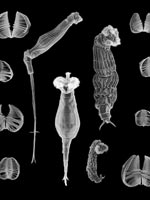Sex is, on the whole, a good thing. I know it, you know it, and natural selection knows it. But try telling it to bdelloid rotifers. These small invertebrates have survived without sex for some 80 million years.
 While many animals, from aphids to Komodo dragons, can reproduce asexually from time to time, it’s incredibly rare to find a group that have abandoned sex altogether. The bdelloid rotifers (pronounced with a silent b) are an exception.
While many animals, from aphids to Komodo dragons, can reproduce asexually from time to time, it’s incredibly rare to find a group that have abandoned sex altogether. The bdelloid rotifers (pronounced with a silent b) are an exception.
They live in an all-female world and since their discovery, not a single male has ever been found. Genetic studies have confirmed that they are permanently asexual, and females reproduce by spawning clone daughters that are genetically identical to them.
The bdelloids pose a problem for evolutionary biologists, who have struggled to explain how they could make do without a strategy that serves the rest of the animal kingdom very well. Now, Natalia Pouchkina-Stantcheva, Alan Tunnacliffe and colleagues from the University of Cambridge have found out how they do it.
Sexual animals have two copies of each gene that have only minimal differences between them. But the asexual bdelloid lifestyle has uncoupled the fates of each copy in a gene pair, allowing them to evolve in new directions. They get two genes for the price of one.
Why have sex?
One of the vaunted benefits of sex is that it acts as a crucible for genetic diversity. Animals receive one pair of every gene from their mother and one from their father. As the pairs are united in the embryo, they are often shuffled into new combinations.
This genetic mingling can unite beneficial mutations in individuals who reap extra benefits. It can also unite harmful mutations in individuals that perform poorly in nature’s trials and are weeded out. In this way, sex speeds up the spread of both beneficial mutations and the disappearance of harmful ones.
Asexual reproduction carries none of these benefits and some scientists see it as a poor and plodding long-term strategy that leaves a species unable to quickly adapt to new challenges. But the bdelloids are proof that permanent asexuality works and they have a way of creating genetic diversity that is all their own.
The genetic shuffling that accompanies sex means that even though an individual has two copies of every gene, they are mostly the same. Small differences between the two copies can have significant effects, but they are small differences nonetheless. For example, in other rotifer groups that still practice sex, an individual’s gene pairs are at least 97.6% identical to each other.
But in the asexual bdelloids, a daughter inherits both copies of each gene from its mother and they never mingle. This frees them to evolve in their own directions and take on new roles, irrespective of the destinies of their partner.
Two-for-one on protein functions
Pouchkina-Stantcheva found evidence of this in a gene called lea from the bdelloid Adineta ricciae. The two copies of this gene differ by about 14% of their sequence, and these small differences translate to proteins with substantially different structures and functions.
Bdelloids live in freshwater pools but can survive periods of drought by dehydrating and living in a dry and dormant state. Both LEA proteins protect the animal in this state, but they do so in complementary ways.
Version A acts as a molecular shield and prevents more sensitive proteins from balling together into useless clumps when they dry out. Its partner, version B, insinutates itself into the fatty membranes that surround all cells and helps to stabilise them.
By sending two copies of a single gene down different evolutionary paths, natural selection has provided A.ricciae with two separate ways of protecting itself from drought. The researchers believe that this two-for-the-price-of-one deal on protein diversity helps to compensate for the loss of diversity that accompanies a shunning of sex.
Many major evolutionary steps have occurred through a remarkably similar process called ‘gene duplication’. During the genetic shuffle that accompanies sex, a gene is mistakenly duplicated an the extra redundant copy is free to evolve new functions.
The bdelloids use essentially the same process but they don’t need to create another copy of their genes when they already have two independent copies. It’s a strategy that doesn’t seem to have held them back – about 400 different species of bdelloid rotifers swim in today’s ponds.
More on asexual reproduction: Christmas special – Virgin birth by Komodo dragons
More on animal sex: Chimerism, or How a marmoset’s sperm is really his brother’s
When the heat is on, male dragons become females
Aphids get superpowers through sex
Reference: Pouchkina-Stantcheva, McGee, Boschetti, Tolleter, Chakrabortee, Popova, Meersman, Macherel, Hincha & Tunnacliffe. 2007. Functional divergence of former alleles in an ancient asexual invertebrate. Science 318: 268-271.
Filed under: Animal behaviour, Animal evolution, Animal kingdom, Evolution, Invertebrates, Sex | Tagged: , asexual reproduction, bdelloid, rotifers |











I was going to call them prudes, but they’re very interesting prudes.
So they can evolve individually? Like in the span of one generation?
Well their gene pairs are free to pick up new changes independently of each other, and that can happen over the span of a generation.
[…] Bdelloid rotifers – 80 million years without sex […]
I am in 9th grade taking Biology. We just studied mitosis and meiosis. I was wondering if the rotifers undergo meiosis.
Mallory, thanks for the question. As far as we know, rotifers don’t undergo meiosis. However, at least one group of researchers is trying to see if they still have any meiosis genes. They want to see if it’s actually possible for rotifers to go through meiosis and have sex, and it’s just that they choose not to.